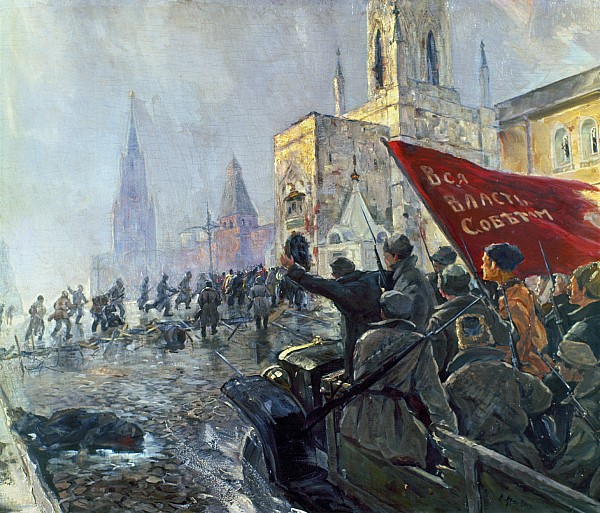Ch-ch-ch-ch-changes
Part 1 of 2: Read the following summary of the Russian Revolution in November 1917.
At the end of the 19th century, many Russians were deeply dissatisfied with the Czarist monarchy and backward social and economic conditions in their country. Some favored transforming Russia into a modern constitutional democracy similar to governments in Western Europe. Other dissidents had even more radical ideas and in 1881, one of the groups was responsible for the assassination of Czar Alexander II. His successor, Alexander III, responded by placing harsher political restrictions on the Russian people.
In this repressive climate, Russian Socialists tried to mobilize the small urban working class, what was known in Marxist ideology as the proletariat, into a revolutionary movement. However, the Socialists were divided. The Mensheviks (minority faction) believed the revolution would have to wait until the Russian working class grew in size and political awareness. Vladimir Lenin, the leader of the Bolshevik group, argued that a small, tightly controlled, revolutionary party could be the vanguard of the proletarian forces, lead the struggle for broad social change and essentially seize state power.
The fundamental weaknesses of the Czarist regime were exposed by two events in 1904-1905. Russia was humiliated in a short war with Japan. Defeat contributed to a series of protests by farmers, workers and soldiers. On a Sunday in January, 1905, workers in Petrograd (St. Petersburg) marched on the royal palace demanding reforms. The palace guard opened fire on the unarmed demonstrators, killing or wounding hundreds. In response to the massacre, a wave of strikes forced Czar Nicholas II to agree to the formation of the Duma, Russia’s first parliament. The Duma largely played a symbolic role until the outbreak of the World War I.
Russia entered the war on the side of England and France with the stated intent of protecting its “Slavic” brothers in the Balkans from Germanic oppression. However its unprepared and ill- equipped army suffered major defeats, millions of battle deaths, and the loss of territory in Poland and Ukraine. War casualties and food shortages in urban areas led to rioting by workers and students. In Petrograd, a strike by women textile workers led to a city-wide general strike in March, 1917. The Czar ordered troops to break the strike and end the riots, but the soldiers refused and joined the demonstrators. With his support evaporating, Nicholas II abdicated as czar.
Several different groups maneuvered to establish a new Russian government. A Provisional administration under the leadership of Alexander Kerensky represented educated Russians who identified with Western political freedom. This group decided to continue the war effort, which proved to be a fatal error. The Kerensky government was challenged by the powerful and well- organized Petrograd Soviet (workers council) which had played a major role in deposing the Czar. The Petrograd Soviet demanded withdrawal from the war, land for peasants and rights for workers and unions. It gradually came under the leadership of Vladimir Lenin and the Bolsheviks. In November, 1917, Bolshevik forces lead by Lenin’s lieutenant, Leon Trotsky, seized government buildings in Petrograd and declared themselves in control of Russia.
In many ways the November Revolution was only the start of the Russian Revolution. There was no effective army or administrative structure. In the cities people were hungry and the countryside was in chaos. Many ethnic minorities that had been part of the Czarist Empire began to demand independence. There were also no clear guidelines in Marxist ideology for governing by a small party that had seized power through a military coup.
In order to rebuild Russia, the Bolsheviks decided to sign a peace treaty with Germany. However, warfare continued to plague the country. There was internal opposition to the revolutionary government and later, when the western allies were victorious over Germany, they supported Russian military forces that wanted to install an anti-Communist coalition in power. In response to internal dissent and foreign intervention, Lenin declared a “dictatorship of the proletariat” under the direction of the Bolshevik (now called Communist) Party, and used force to defeat all opposition. Among the victims were Czar Nicholas and his family, who were executed in July, 1918.
Vladimir Lenin died in January, 1924 and after a five year battle for control over the Communist Party and the government, Josef Stalin was declared his successor. Under Stalin, there was increasing ideological and economic rigidity that injured many Russians and communism became identified with a brutal and oppressive dictatorship.
Part 2 of 2: Answer the following questions.
- What impact did the assassination of Alexander II have on the political climate of Russia?
- What issue divided the Mensheviks and Bolsheviks?
- What two events eroded faith in the power and authority of the Czar?
- What is the Duma?
- How did Russia’s role in World War I lead to a revolt and later a revolution?
- The Kerensky led government committed a major blunder that resulted in its downfall. What was this blunder?
- What actions did the Bolsheviks take the gained the support of many soldiers and their families?
